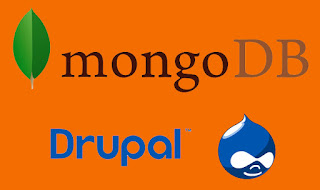Install & Configure Drupal 7 with MongoDB on CentOS/RHEL 6x
Q. What is Drupal?
-- Drupal is content management software. The application includes a content management platform and a development framework. It's used to make many of the websites and applications you use every day. Drupal has great standard features, like easy content authoring, reliable performance, and excellent security.
Step: 1. Bind Hosts File :
# vi /etc/hosts
10.100.99.214 drupal.domain.com drupal
-- Save & Quit (:wq)
Step: 2. Disable Selinux & Stop Firewall :
# vi /etc/sysconfig/selinux
SELINUX=disabled
-- Save & Quit (:wq)
# service iptables stop
# chkconfig iptables off
Step: 3. Install NTP Server (for Time Syncronization) :
# yum -y install ntp
# service ntpd restart
# chkconfig ntpd on
# ntpdate pool.ntp.org
Step: 4. Install Apache Server :
# yum -y install httpd httpd-devel
Step: 5. Install PHP 5.6 :
# yum -y install epel-release
# rpm -Uvh https://mirror.webtatic.com/yum/el6/latest.rpm
# yum -y install php56w php56w-cli php56w-devel php56w-common php56w-mbstring \
php56w-gd php56w-xml php56w-mcrypt php56w-mysqlnd php56w-imap php56w-pdo \
php56w-snmp php56w-soap php56w-xmlrpc php56w-opcache php56w-iconv \
php56w-ldap php56w-pear mod_ssl wget
Step: 6. Install MySQL Server 5.6 :
# rpm -Uvh http://repo.mysql.com/mysql-community-release-el6-5.noarch.rpm
# yum -y install mysql mysql-server
Step: 7. Finally Restart the Apache Service :
# service httpd restart
# chkconfig httpd on
Step: 8. Start MySQL Service & Set Root Password :
# service mysqld restart
# chkconfig mysqld on
# mysql_secure_installation
Step: 9. Create Database for Drupal :
# mysql -u root -p
Enter Password:
mysql> create database drupaldb;
mysql> grant all privileges on drupaldb.* to drupal@localhost identified by 'password';
mysql> grant all privileges on drupaldb.* to drupal@'%' identified by 'password';
mysql> flush privileges;
mysql> exit
Step: 10. Download & Extract Drupal Source Code :
# cd /var/www/html/
# wget http://ftp.drupal.org/files/projects/drupal-7.50.tar.gz
# tar -zxvf drupal-7.50.tar.gz
# mv drupal-7.50 drupal
# chown -Rf apache:apache /var/www/html/drupal
Step: 11. We need to Create Settings file from the default.settings.php File :
# cd /var/www/html/drupal/sites/default/
# cp -p default.settings.php settings.php
# chmod a+w /var/www/html/drupal/sites/default/settings.php
# chmod a+w /var/www/html/drupal/sites/default/
Step: 12. Enable Apache mod_rewrite Module & Set Date-Time In php.ini :
# vi /etc/httpd/conf/httpd.conf
Line No: 338
AllowOverride None To AllowOverride All
At the End, Add this Line :
RewriteEngine on
-- Save & Quit (:wq)
# vi /etc/php.ini
date.timezone = "Asia/Kolkata"
-- Save & Quit (:wq)
# service httpd restart
Step: 13. Install Drupal Through Web Browser :
http://10.100.99.214/drupal/core/install.php
-- Choose Profile: Standard & Clcik on "Save & Continue"
-- Choose Language: English & Click on "Save & Continue"
-- Database Configuration:
Database Type: Select "MySQL, MariaDB, Percona Server, or equivalent"
Database Name: drupaldb
Database Username: drupal
Database Password: password
-- Clcik on "Save & Continue".
-- SITE INFORMATION:
Site Name: drupal.domain.com
Site Email Address: koushik@domain.com
-- SITE MAINTENANCE ACCOUNT:
Username: admin
Password: Passw0rd
Confirm Password: Passw0rd
-- REGIONAL SETTINGS:
Default Country: India
-- Click on "Save & Continue"
-- Click on "View Your New Site."
Step: 14. Install & Configure MongoDB :
# vi /etc/yum.repos.d/mongodb.repo
[mongodb]
name=MongoDB Repo
baseurl=http://downloads-distro.mongodb.org/repo/redhat/os/x86_64/
gpgcheck=0
enabled=1
-- Save & Quit (:wq)
# yum -y install mongo-10gen mongo-10gen-server
# vi /etc/mongod.conf
## Change Line Number 19 "bind_ip"
bind_ip=0.0.0.0
-- Save & Quit (:wq)
# service mongod restart
# chkconfig mongod on
Step: 15. Install MongoDB Driver :
# yum -y install gcc openssl-devel
# pecl install mongo
Build with Cyrus SASL (MongoDB Enterprise Authentication) support? [no] : Just Press Enter.
Step: 16. Add the Extension in php.ini File :
# vi /etc/php.d/mongo.ini
extension=mongo.so
-- Save & Quit (:wq)
Step: 17. Finally Restart the Apache Service & Verify :
# service httpd restart
# php -i | grep mongo
Step: 18. Install MongoDB Module in Drupal :
# cd /opt
# wget http://ftp.drupal.org/files/projects/mongodb-7.x-1.x-dev.tar.gz
# tar -zxvf mongodb-7.x-1.x-dev.tar.gz
# mv mongodb /var/www/html/drupal/sites/all/modules/
# chown -Rf apache:apache /var/www/html/drupal/sites/all/modules/mongodb
# cd /var/www/html/drupal/sites/default
# vi local.settings.php
<?php
# MongoDB
$conf['mongodb_connections'] = array(
'default' => array(
'host' => 'localhost',
'db' => 'drupal', // Database name. Mongodb will automatically create the database.
'connection_options' => array( 'replicaSet' => 'my_mongodb_0' ),
),
);
include_once('./includes/cache.inc');
# -- Configure Cache
$conf['cache_backends'][] = 'sites/all/modules/mongodb/mongodb_cache/mongodb_cache.inc';
$conf['cache_class_cache'] = 'DrupalMongoDBCache';
$conf['cache_class_cache_bootstrap'] = 'DrupalMongoDBCache';
$conf['cache_default_class'] = 'DrupalMongoDBCache';
# -- Don't touch SQL if in Cache
$conf['page_cache_without_database'] = TRUE;
$conf['page_cache_invoke_hooks'] = FALSE;
# Session Caching
$conf['session_inc'] = 'sites/all/modules/mongodb/mongodb_session/mongodb_session.inc';
$conf['cache_session'] = 'DrupalMongoDBCache';
# Field Storage
$conf['field_storage_default'] = 'mongodb_field_storage';
# Message Queue
$conf['queue_default_class'] = 'MongoDBQueue';
?>
-- Save & Quit (:wq)
# chown apache:apache local.settings.php
# chmod 644 local.settings.php
# sed -i 's|localhost|10.100.99.214|g' /var/www/html/drupal/sites/all/modules/mongodb/mongodb.module
# sed -i 's|localhost|10.100.99.214|g' /var/www/html/drupal/sites/all/modules/mongodb/mongodb.drush.inc
http://10.100.99.214/drupal/admin/modules
Note: Now Open the Admin Panel of Drupal & Uncheck the "Block" & "Dashboard" from the Modules & Check all the Modules of MongoDB Section except "MongoDB Cache" & "MongoDB Migrate".
-- Click on "Save Configuration."
# mongo
mongo> show dbs
admin (empty)
drupal 0.078GB
local 0.078GB
mongo> use drupal
mongo> show collections
session
system.indexes
watchdog
watchdog_event_3f71fc116d395612bd0b3dd8e022dc09
watchdog_event_782ddf217853242a4f40f642a4792b9e
watchdog_event_d29d18b2c99dc1af6e22838feee53c62
mongo> exit
** That mean the MongoDB has been Successfully Integrated with the Drupal.
Thanks For Visiting on My Blog, For More Tutorials Keep Visiting My Blog


0 comments:
Post a Comment